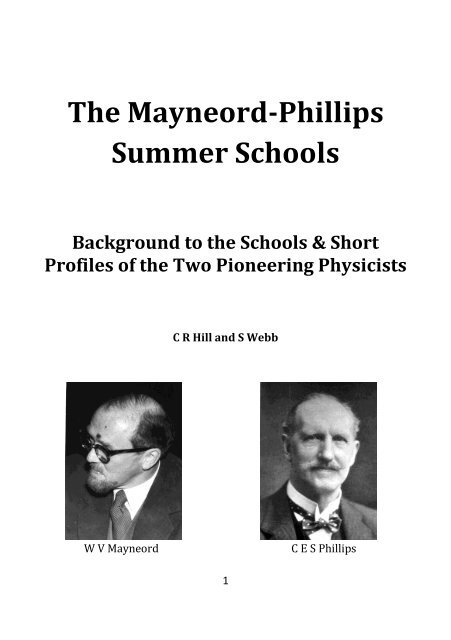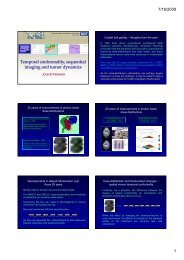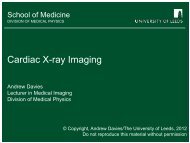here - The Mayneord Phillips Trust
here - The Mayneord Phillips Trust
here - The Mayneord Phillips Trust
Create successful ePaper yourself
Turn your PDF publications into a flip-book with our unique Google optimized e-Paper software.
<strong>The</strong> <strong>Mayneord</strong>-<strong>Phillips</strong>Summer SchoolsBackground to the Schools & ShortProfiles of the Two Pioneering PhysicistsC R Hill and S WebbW V <strong>Mayneord</strong>C E S <strong>Phillips</strong>1
Background to the Summer Schools<strong>The</strong> <strong>Mayneord</strong>-<strong>Phillips</strong> <strong>Trust</strong> was established in 1991 to commemoratethe work of the late Professor W V <strong>Mayneord</strong>, and Major C S <strong>Phillips</strong>. <strong>The</strong><strong>Trust</strong> was founded and continues to be supported by the Institute ofPhysics, the British Institute of Radiology and the Institute of Physics &Engineering in Medicine. <strong>Trust</strong>ees are drawn from the membership of thefounding bodies and serve for a term of three years.<strong>The</strong> main activity of the <strong>Trust</strong> is the organisation of biennial SummerSchools on topical areas of medical physics, primarily aimed at PhDstudents, post-doctoral researchers early in their careers and medicalphysics trainees.Profiles of two pioneering PhysicistsW V <strong>Mayneord</strong> and C E S <strong>Phillips</strong> were two outstanding pioneers of theapplications of Physics to Medicine. In their nature as pioneers they bothhad strong concern to help and encourage younger colleagues developtheir own interests and expertise in this worthwhile and stimulating field.A number of their former colleagues and successors, members of thescientific societies with which <strong>Mayneord</strong> and <strong>Phillips</strong> were themselvesclosely associated, share this concern and have felt that an effectiveexpression of it would be a series of summer schools that would exploresome of the currently active developments in the various applications ofPhysics to Medicine.We hope that the following short accounts of the careers of <strong>Phillips</strong> and<strong>Mayneord</strong> will give participants in the Summer Schools, and others, animpression of these two individuals as real working scientists, onlyseparated from the rest of us by the accident of time.2
Major Charles Edmund Stanley <strong>Phillips</strong>Major <strong>Phillips</strong> has been described as the first British medical physicist.Born in 1871, he was educated privately, never attending College. AGentleman Scientist, he knew well such men as Kelvin and Crookes.Primarily an experimentalist he worked at home and was, in commonwith many contemporary physicists, studying the electrical discharge inevacuated glass tubes at the time of RÖntgen’s discovery of X-rays on 8 thNovember 1895. His laboratory notebooks are preserved in the library of<strong>The</strong> Institute of Cancer Research.Experiments with discharge tubes led to the observation of the rotation ofa luminous ring in the electrical discharge tube within a static magneticfield; the effect soon became known as the “<strong>Phillips</strong>’ Phenomenon”. Hisnotebooks detail how he brought this to the personal attention ofestablished physicists such as Crookes and Silvanus Thompson and hisecstasy when being allowed to publish in the Proceedings of the RoyalSociety. <strong>The</strong>se were the days when FRS patronage was the only way ofhaving one’s work appear in this revered journal. His notebooks containexquisite line drawings of his apparatus with blow-by-blow accounts ofwhat he achieved (and what went wrong) with his experiments. Such washis joy being noticed by Crookes that he even stuck into the notebook theenvelope of the letter bearing the news of his paper’s acceptance by theRoyal Society.In the autumn of 1896 he began, for reasons that are not known, to recordall his daily notes in Pitman shorthand, an annoyance for today’shistorian. In 1897 he published a book listing a complete bibliography ofX-ray literature, a task just possible at the time and almost certainlyimpossible t<strong>here</strong>after. <strong>The</strong> work also contained all sorts of practical tipson how to make one’s own equipment.In the early 1900’s <strong>Phillips</strong> became interested in quantitative radiationand in 1909 he was commissioned to prepare three small radiumstandards which were calibrated against a standard in Rutherford’slaboratory and then presented to the RÖntgen Society of which he was a3
founder member and President in 1909-1910. <strong>The</strong> standards arepreserved by the British Institute of Radiology. During the 1914-1918War he was physicist to the X-ray Committee of the War Office w<strong>here</strong> headvised on such things as high-voltage equipment for X-ray tube supply.Taking advantage of the luminosity of zinc sulphide he had made, evenbefore 1914, the first “night marching compass” the first model of whichis preserved in the London Science Museum.At a time when physics as Applied to Medicine was a considerablenovelty, the radiologist Robert Knox invited Major <strong>Phillips</strong> to becomehonorary physicist to the Cancer Hospital, London (now the RoyalMarsden NHS Foundation <strong>Trust</strong>) w<strong>here</strong> he worked until the retirement in1927 on the development of the scientific basis of radiotherapy, ontechniques for manipulating radioactive substances and in radiationprotection.Despite his own lack of public education <strong>Phillips</strong> fostered education in thephysical principles of radiation in medicine. He was honorary lecturer inradiology at University College and lectured on X –ray physics to medicalorderlies to overcome the shortage of radiographers. <strong>The</strong> X –ray physicslectures at the Royal Herbert Hospital, Woolwich and at Imperial Collegewere also taken care of by <strong>Phillips</strong>. He was awarded the O.B.E (Military)for services. He would surely have approved of the “<strong>Mayneord</strong> – <strong>Phillips</strong>Summer School”.<strong>Phillips</strong> played an important role in the X-ray Societies. He was Presidentof the British Institute of Radiology in 1930-31, a founder member andHonorary Treasurer of the Institute of Physics, Honorary Secretary of theRoyal Institution from 1929 to 1945 and a Founder member of the Societyof Radiographers.Major <strong>Phillips</strong> was an accomplished musician, owning and playing aStradivarius violin. He made, repaired and played both violin and spinets.An accomplished artist, he also exhibited at the Royal Academy. Hisportraits of Dr Knox and Sir Archibald Reid hang in the entrance hall atthe British Institute of Radiology; his portrait of Sir William Bragg is in the4
Royal Institution. At the time of his death in 1945 he was working on acommemorative portrait of RÖntgen for the fiftieth anniversary. His wifedesigned the Presidential Badge still worn by the holder of the highestoffice in the British Institute of Radiology.Steve WebbProfessor William Valentine <strong>Mayneord</strong>, FRSVal <strong>Mayneord</strong> started his first job in medical physics, at St Bart’s hospital,London in 1924, at the age of 22. That was, of course , a time whenradiotherapy was in its infancy; t<strong>here</strong> was almost no scientific basis forradiation dosimetry , artificial radioisotopes and pulse-echo ultrasoundwere still 20 odd years in the future, and the concept of radiationprotection was unheard of.Within 30 years all that had changed; medical physics had achieved muchof its present –day structure, character and rigour; and, although manyindividuals had contributed to this development and much useful groundwork had previously been laid by people like C E S <strong>Phillips</strong>, a remarkableproportion of the intellectual leadership and sheer physical hard workbehind it was that of <strong>Mayneord</strong>. Indeed, any modern medical physicistwith an interest in the origin of his or her subject is warmlyrecommended to read <strong>Mayneord</strong>’s official biography (1), which is one ofthe most lively and illuminating brief histories of medical physics that hasbeen written.In the 1920’s radiotherapy was largely based on surgical implantation ofradium needles and, at Bart’s, <strong>Mayneord</strong> worked with Geoffrey Keynes, apioneering surgeon and brother of Maynard , the economist, who in hisautobiography described how, in this work, surgeons such as himself hadto put themselves “completely in the hands of the physicist”.His firsthand experience at that time of the sometimes appalling radiationinjuries to both patients and staff made a deep impression on him and,very soon after his move, in 1927, to the Cancer Hospital (now Royal5
Marsden), he started making major contributions to the modern subjectof radiation dosimetry. He had a major hand in making the case for anionization method for the measurement of X-ray dose, and hence indefining and establishing the RÖntgen and subsequently in the movetowards the absorbed dose and the rad. It was also he at that time whointroduced the concept, that was to become central to radiationprotection, of integral dose. It was once remarked that the RÖntgen wasthe quantity that we could measure but did not want, the rad was whatwe wanted but could not measure, whilst kerma was neither wanted normeasurable. That may have been an overstatement but certainly, when in1960 <strong>Mayneord</strong> first heard that this new radiological quantity was beingintroduced without his having been involved, he remarked to a colleaguethat it was surely time for him to retire!However retirement was still a long way off when the Second World Warbroke out and when, immediately after it, Val was seconded by theGovernment to a year’s consultancy in Canada in connection with theradiobiological aspects of atomic energy development. He returned fromthis to London, according to a colleague “brimming with new ideas, bothtechnically and in relation to the scope of physics in medicine. Inparticular he saw that the work had to be broadened to take advantage ofall the new developments in electronics and to exploit the excitingmedical possibilities of nuclear physics”. Thus, within a few years , hisdepartment was reporting pioneering work, and the first outside theU.S.A, both in diagnostic ultrasound and in nuclear medicine, includingconstruction of one of the world’s first radioisotope scanners – precedingthe gamma camera by some 10 years. As another practical response to thenuclear age, <strong>Mayneord</strong> established, in the 1950’s, a major researchprogramme that made a substantial (and importantly at that stage,academically independent and objective) documentation of man’s naturaland artificial radiation environment.This was, in a sense, a practical expression of his long-standing interest inradiation carcinogenesis and it was to the more philosophical andtheoretical aspects of this complex subject that his attentions returnedduring a long and active “retirement” leading in particular top publication6
of a “Biomathematical Reconnaissance” of the subject, which has becomea classic in the field (2).Perhaps even more important than his own personal scientificachievements was his building up of an internationally renowneddepartment of “physics as applied to medicine” (he never liked the termMedical Physics, believing as he did that physics is one entity,fundamental and indivisible!). He achieved this, partly by having thevision to see that good medicine must be based on good science and thatgood physical scientists need a strong and stimulating environment inwhich to thrive, and partly by a personality that somehow inspiredloyalty, friendship and respect in just the right proportions. For those whohad the good fortune to work with him he was an inspiring teacher,sometimes a hard task master, but always a sensitive , supportive, andvery human colleague and friend.References1. Spiers F.W (1991), William Valentine <strong>Mayneord</strong>, in BiographicalMemoirs of the Royal Society, 37, 341-364.2. <strong>Mayneord</strong> W. V and Clarke R. H (1975) Carcinogenesis andradiation risk: a biomathematical reconnaissance. Brit. J. Radiol.Supplement 12Kit Hill7
Cour de la Sorbonne 1931. Pictured from the left: Professor Hopwood, DrThurston-Holland, Major <strong>Phillips</strong>, Dr Kay, Dr Lynham, Brigadier MacGrigor andProfessor <strong>Mayneord</strong>.First published in June 1993; new version published June 20098





